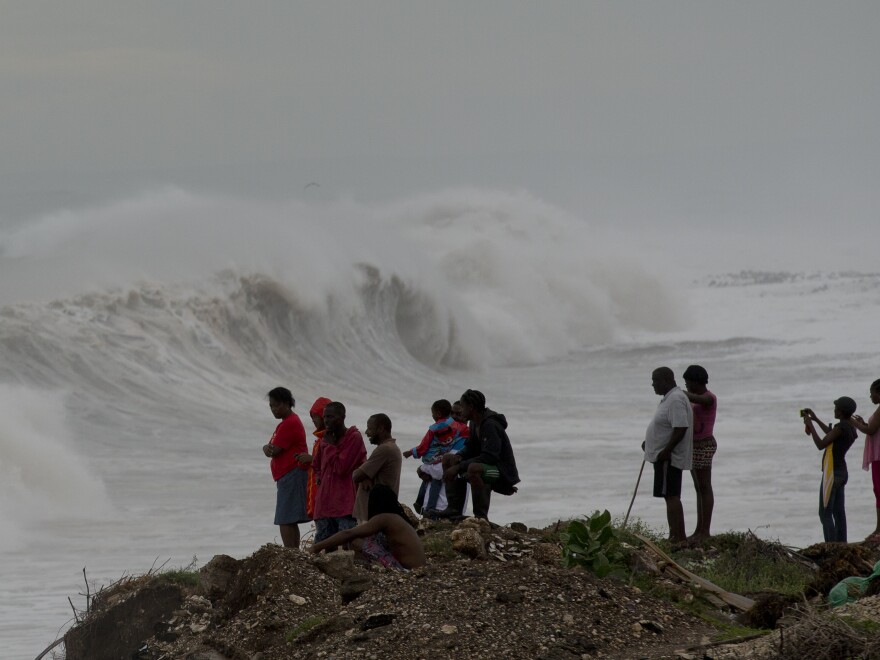Updated at 4:45 p.m. ET with further states of emergency in the U.S.
Hurricane Matthew crashed into southwestern Haiti as a Category 4 storm Tuesday morning, dumping rain and scouring the land with maximum sustained winds of 145 miles per hour.
It is the first Category 4 storm to make landfall in Haiti since 1964, when Hurricane Cleo also hit the island nation's southwestern peninsula.
At 7 a.m. local time, the eye of Hurricane Matthew sat over Les Anglais, Haiti. The hurricane is so large and powerful that people in a 40-mile radius from its center were under hurricane warnings, and tropical storm-force winds were lashing areas as far as 185 miles away, near the Haitian capital of Port-au-Prince.
News reports said that at least four people in the Caribbean have died as a result of the storm, including two in Haiti.
According to the Miami Herald, radio reports from the southern port of Les Cayes described shoulder-high floodwaters and sea water rushing into people's homes farther east in Cote de Fer. The National Hurricane Center predicts the storm surge from Hurricane Matthew is between 7 and 10 feet above normal tides.
Describing his district on the northern coast of the hard-hit peninsula, Haitian Sen. Nenel Cassy told the Miami Herald "the situation in the Nippes [region] is truly catastrophic."
"The amount of rain we're seeing accumulate is enormous," the assistant director of the aid organization CARE in Haiti, Laura Sewell, told NPR on Tuesday morning. Speaking from Port-au-Prince, she said she had heard informal reports of mudslides elsewhere in the country. "What we're looking at here is a lot of flooding. Haiti is very mountainous so there's a good chance of landslides and mudslides."
Sewell said the organization is particularly worried about people in rural areas.
"The south has 60,000 pregnant women," she said. "What's going to happen with those women during this time when access to medical care will be reduced? It's something we're really worried about now." She also said she is concerned about the risk of a cholera outbreak after the storm. Thousands of people have died of cholera in Haiti since it was introduced in 2010 by United Nations aid workers.
The United Nations is concerned about the potentially devastating effects of such an outbreak on the more than 4 million children it estimates could be affected by Hurricane Matthew.
"This is the worst storm Haiti has seen in decades and the damage will no doubt be significant," Marc Vincent, UNICEF's representative in Haiti, said in a statement Tuesday. "Waterborne diseases are the first threat to children in similar situations — our first priority is to make sure children have enough safe water."

As it moves away from Haiti on Tuesday morning, the hurricane is expected to head north through the Windward Passage between Haiti and Jamaica, where large waves are already threatening the coast near the capital, Kingston, before turning northwest on Wednesday. The storm is moving slowly — when it made landfall in Haiti, it was traveling just 9 miles an hour — and is on track to skirt eastern Cuba on Tuesday afternoon and the Bahamas overnight.
As the hurricane turns northwest, it could impact the U.S. East Coast later this week. Florida's governor, Rick Scott, declared a state of emergency for every county in the state to "ensure we have resources for evacuations, sheltering and other logistical needs."
The National Hurricane Center says a hurricane watch is in effect from Deerfield Beach, Fla., to the Volusia/Brevard county line.
A Tropical Storm Watch is in effect from the Seven Mile Bridge in the Florida Keys northward to south of Deerfield Beach, including Lake Okeechobee.
Georgia's governor, Nathan Deal, also declared a state of emergency for 13 counties in that state's coastal areas.
In South Carolina, Governor Nikki Haley said at a press conference she had declared a state of emergency and would close 31 coastal schools and evacuate about a million people away from the coast beginning Wednesday. "Fill your car up with fuel," she told residents facing evacuation, directing people to the state's emergency management website for evacuation routes.
North Carolina's governor, Pat McCrory declared a state of emergency for portions of his state, although the storm is likely still days away from affecting Mid-Atlantic states.
Copyright 2021 NPR. To see more, visit https://www.npr.org. 9(MDA5NTM4MTIyMDE0MTg3NDc2MTVlZjdmNQ001))



